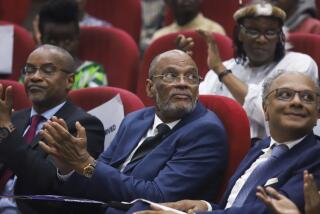Political stalemate drags on in Nepal
KATMANDU, NEPAL â Voters in every country get frustrated with politicians, but Nepalese have especially good reason to roll their eyes.
More than four months ago, the parliament held a vote to replace the prime minister, who had resigned June 30. Then it held a second election. And then a third.
At last count there have been 16 attempts to elect a replacement for Madhav Kumar Nepal, who has stayed on as caretaker prime minister. An interim budget has covered the South Asian nationâs basic costs until a new leader is picked.
On top of that, efforts to write a constitution continue to drag, as political turmoil persists even after a 2006 peace accord ended a decade-long insurgency by Maoists.
Newspapers have called the political impasse a charade, a burlesque, a ânever-ending exercise in futility.â Many Nepalese find it all somewhere between embarrassing and amusing.
âI donât want to get into the intricacies of why we donât have a prime minister after [16] tries,â said Kunda Dixit, publisher of the Nepali Times. âInternational audiences donât care. Even we donât care.â
In fact, the search for a new leader began after Prime Minister Nepal resigned in the face of a political impasse. Since then, no candidate has received the required support of more than half the 601-member parliament. The next vote is to be held Monday, when the interim budget runs out.
Other problems exact a real cost. Nepal hasnât had local elections in years and many government councils remain vacant, forcing people to travel long distances for essential documents such as driverâs licenses and citizenship papers. Public services are grinding to a halt.
âThese leaders never think of us,â said Sumitra Shakya, 41, a Katmandu homemaker. âThey do what they want. I can hardly read the news anymore.â
At the heart of it all is a struggle for power and control mixed with lots of ego, limited trust and few willing to compromise. Nepal is a new republic; its 240-year-old monarchy ended in 2008, with Ram Baran Yadav becoming the countryâs first president.
The political sides include the outgoing prime ministerâs Communist Party (Unified Marxist Leninist), known as UML. Then there is the Unified Maoistsâ group, Nepalâs largest party, which joined the political process after a decade of fighting in the trenches. It accuses the political establishment of privileged castes that ran the country for centuries of corruption and arrogance. But it lacks a majority in the parliament.
âIf we hadnât taken the initiative, these other parties would never have even moved against the monarchy,â said Baburam Bhattarai, the partyâs vice chairman.
Elsewhere in the political landscape are 22 parties led by the Nepali Congress, largely united by their distrust of the Maoists, whom they accuse of reneging on pledges to renounce violence and return land captured during the 1996-2006 civil war. Squabbling within the Maoist camp further complicates the picture.
âI can understand peopleâs frustration with the political impasse,â said Ram Sharan Mahat, a Nepali Congress leader. âBut they should pinpoint who is the main stumbling block, the Maoistsâ love of violence. Theyâve refused to fulfill their promises.â
Few believe the Maoists will pick up their guns again, at least not in sizable numbers. Theyâve tasted power, analysts said, they prefer soft beds to roughing it and have their fingers in various economic pies now. But theyâre also reluctant to completely disarm without getting something in return.
A solution remains elusive in part because so many problems are interconnected.
âThereâs a significant trust deficit between all parties,â said Sarah Levit-Shore, country representative for the Carter Center based in Atlanta.
On the sidelines, the United Nations, the United States, various European Union nations, India and China have repeatedly urged Nepal to forge a government, approve a constitution, and move the peace process along.
The U.N. mission in Nepal is supervising about 19,500 former Maoist fighters who have been housed in 28 camps. The military, formerly the Royal Nepalese Army and traditionally loyal to the monarchy, has resisted a pledge to absorb 4,000 to 5,000 ex-Maoist fighters and make changes aimed at bringing it fully under civilian rule.
With little progress in sight, the U.N. mission has vowed to leave by Jan. 15, fueling hope that this deadline will focus political minds. But many are skeptical.
âThereâs no sense of urgency,â said Binod Bhattarai, an analyst and columnist at large. âNo oneâs thinking beyond their noses.â
Activists and residents say they remain concerned by ongoing violence and disputes that are settled by political parties or their youth wings instead of judges or police.
But some also say there are signs of progress considering the countryâs difficult transition from civil war. They note that the news media no longer kowtow to the state, the main parties are at least talking and the parliament is far more representative, with numerous women, ethnic minorities and so-called untouchables.
At Katmanduâs Dhokaima Cafe, run by publisher Dixitâs family, a steel telephone pole in the garden bears bullet holes from a protracted battle between Maoists and police officers at Beni in 2006, a reminder of how bad things were.
âI sure hope the future will be good,â said Anju Sharma, an architecture student. âWe really need some good leadership soon.â
--
More to Read
Sign up for Essential California
The most important California stories and recommendations in your inbox every morning.
You may occasionally receive promotional content from the Los Angeles Times.










